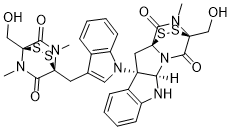| Cas No.: | 1403-36-7 |
| Chemical Name: | 3,11a-Epidithio-11aH-pyrazino[1',2':1,5]pyrrolo[2,3-b]indole-1,4-dione,2,3,5a,6,10b,11-hexahydro-3-(hydroxymethyl)-10b-[(1S,4S)-3-[[4-(hydroxymethyl)-5,7-dimethyl-6,8-dioxo-2,3-dithia-5,7-diazabicyclo[2.2.2]oct-1-yl]methyl]-1H-indol-1-yl]-2-methyl-,(3S,5aR,10bS,11aS)- |
| Synonyms: | 3,11a-Epidithio-11aH-pyrazino[1',2':1,5]pyrrolo[2,3-b]indole-1,4-dione,2,3,5a,6,10b,11-hexahydro-3-(hydroxymethyl)-10b-[(1S,4S)-3-[[4-(hydroxymethyl)-5,7-dimethyl-6,8-dioxo-2,3-dithia-5,7-diazabicyclo[2.2.2]oct-1-yl]methyl]-1H-indol-1-yl]-2-methyl-,(3S,5aR,10bS,11aS)-;3,11a-Epidithio-11aH-pyrazino[1',2':1,5]pyrrolo[2,3-b]indole-1,4-dione,2,3,5a,6,10b,11-hexahyd...;3,11a-Epidithio-11aH-pyrazino[1',2':1,5]pyrrolo[2,3-b]indole-1,4-dione,2,3,5a,6,10b,11-hexahydro-3-(hydroxymethyl)-10b-[(1S,4;CHAETOMIN;Chetomin;CHETOMIN(RG);Chetomin,Chaetomin;Chetomin,Chaetomiumspecies;CS-1;CTM;NSC 289491;Stereoisomer of 2,3,5a,6,10b,11-hexahydro-3-(hydroxymethyl)-10b-[3-[[4-(hydroxymethyl)-5,7-dimethyl-6,8-dioxo-2,3-dithia-5,7-diazabicyclo[2.2.2]oct-1-yl]methyl]-1H-indol-1-yl]-2-methyl-3,11a-epidithio-11aH-pyrazino[1',2':1,5]pyrrolo[2,3-b]indole-1,4-dione;HSF4;SSFA2;DKFZp313O1039 |
| SMILES: | O=C1N(C)[C@]2(CO)C(N3[C@]1(SS2)C[C@@]4(N5C=C(C[C@]6(N(C)C7=O)SS[C@]7(CO)N(C)C6=O)C8=C5C=CC=C8)[C@]3([H])NC9=C4C=CC=C9)=O |
| Formula: | C31H30N6O6S4 |
| M.Wt: | 710.866500000001 |
| Purity: | >98% |
| Sotrage: | 2 years -20°C Powder, 2 weeks 4°C in DMSO, 6 months -80°C in DMSO |
| Description: | Chetomin, an active component of Chaetomium globosum, is a heat shock protein 90/hypoxia-inducible factor 1 alpha (Hsp90/HIF1α) pathway inhibitor. Chetomin is a potent, nontoxic non-small cell lung cancer cancer stem cells (NSCLC CSC)-targeting molecule[1]. |
| Target: | HSP90 |
| In Vivo: | Chetomin (0~100 mg/kg; p.o.) inhibits lung tumorigenesis in NSCLC mouse models[1]. .Chetomin markedly decreases tumor formation in several murine models of NSCLC[1]. Animal Model: Mouse Dosage: 0~100 mg/kg Administration: P.o. Result: Inhibited lung tumorigenesis in NSCLC mouse models. |
| In Vitro: | Chetomin (0~10 μM; 24 hours; H460 and H1299 cells) shows progressively lower expression of several survival-promoting proteins promoted by Hsp90/HIF1α activity, including insulin-like growth factor 1 (IGF1 R), epidermal growth factor receptor (EGFR), Src, mitogen-activated protein kinase kinase 1/2 (MEK1/2), activation of protein kinase B (Akt), and mammalian target of rapamycin (mTOR) [1]. Chetomin (0~10 μM; 24 hours; H1299 cells) elicits cell cycle arrest in susceptible and chemoresistant NSCLC cell lines[1]. .Chetomin (1 µM; 3 days; H460 and H1299 cells) pretreatment abolishes their sphere-forming capacity. Chetomin inhibits sphere-forming by NSCLC CSCs within a nanomolar range, and proliferation of susceptible and chemoresistant NSCLC non-CSCs within a micromolar range. Chetomin (24 h) decreases HIF-response element activity in H460 and H1299 monolayer cultures. Chetomin (0~10 μM) specifically inhibits the Hsp90-HIF1α binding interaction in HIF1α's N-terminus [1]. Western Blot Analysis[1] Cell Line: H460 and H1299 cells Concentration: 0~10 μM Incubation Time: 24 hours Result: Showed progressively lower expression of several survival-promoting proteins promoted by Hsp90/HIF1α activity, including insulin-like growth factor 1 (IGF1 R), epidermal growth factor receptor (EGFR), Src, mitogen-activated protein kinase kinase 1/2 (MEK1/2), activation of protein kinase B (Akt), and mammalian target of rapamycin (mTOR). Cell Cycle Analysis[1] Cell Line: H1299 cells Concentration: 0~10 μM Incubation Time: 24 hours Result: Elicited cell cycle arrest in susceptible and chemoresistant NSCLC cell lines. |
| References: | [1]. Min S, et al. Chetomin, a Hsp90/HIF1α pathway inhibitor, effectively targets lung cancer stem cells and non-stem cells. Cancer Biol Ther. 2020;21(8):698-708. |






















